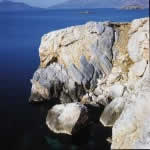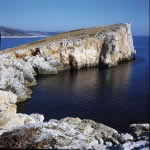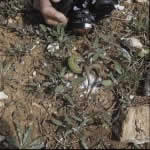During a birding excursion to the English Gardens of Munich, in 1947 I had the privilege to meet Dr. Philipp Lehrs. I was just ten years old, thrilled by the opportunity to learn „live“ more about animals.. Dr. Lehrs was a distinguished, free-working herpetologist. He recognized my keen interest and over several years introduced me to a host of knowledge. He also made available books from his exquisite library which I inherited all when Philipp Lehrs died in 1956.
Among these herpetological publications was the separatum aus den Sitzungsberichten der Österreichischen Akademie der Wissenschaften, „Herpetologia aegaea“ (1953) by Otto von Wettstein of Vienna, dedicated by a personal note to his dear friend Lehrs. Searching at once through the pages I discovered that the herpeto – (as much as the other) fauna on most islands of the Northern Sporades had never been investigated.
Quote from p.703, about Lacerta erhardii ruthveni: „ Diese Rasse bewohnt die Nördlichen Sporaden. Terra typica ist die Insel Kyra Panagia (=Pelagonisi).) Cyrén (1935) stellte sie auf Khiliodromia (=Chelidromia, Xilodromia), Psathura und Giura (=Joura) fest. Piperi, Gramura, die Inselgruppen von Xeronesi und Skantzura, wurden überhaupt noch nicht herpetologisch untersucht.“
And the key quote, from p.757; „Die Skyros umgebenden kleinen Inseln, etwa 11 an der Zahl, und die Leuchtturminsel Präsuda zwischen Skyros und Euböa wurden noch nie herpetologisch untersucht und würden vielleicht interessante Ergebnisse bringen. Ich halte sie für das aussichtsreichste Ziel einer künftigen herpetologischen Forschungsfahrt in die ägäische Inselwelt.“
That was it! Immediately I began planning a first expedition to Skyros and the outer islands of the Northern Sporades. And all follow up exploration and conservation work since – right to the present day when I am writing about this sequence of events in my island retreat of Thassos – was sparked off by these few lines in Otto von Wettstein’s monograph.
A friend from school days, like myself just at the beginning of university terms at Munich, was happy to join me: Wilfried („Pietsch“) Weigand. So in August 1957 we set off for a never ending train journey of over fifty hours to Piraeus, carrying lots of useful as well as never unpacked gear in metal boxes and canvas bags. Pietsch had obtained a letter of introduction by a Greek study collegue to his mother: the good lady did not speak any foreign language and we could not even utter a proper Good Day… Nevertheless we managed to communicate alright, obtained an official permit to enter the island of Gioura from a very helpful Mr. Polychronopoulos at the Ministry of Agriculture, and soon embarked the crowded deck of the steamship Ionion for Skyros. During the night, the tall chimney discharged a constant flurry of soot-flakes; so we were glad to disembark in the bay of Linaria and soon found an empty room to rent – not quite empty, though, because at night hordes of hungry bed bugs approaches us from their hiding places in the wooden floor. DDT (Paral) did a good job, but shortly afterwards we had to combat paratyphoid fever. Fortunately Pietsch was quite knowledgeable about medications and had the very strong antibiotic Terramycin in his bag. At the waterfront of Linaria the bakery of Philippos became our base, because Philipp also run the kafenion for the fishermen and owned himself a barge with engine – so we could reach the nearest islands offshore and search for lizards on this Terra incognita – following the imaginary trail laid by Philipp Lehrs and Otto von Wettstein.
During this and the follow up journey in spring 1958 we visited all 48 larger and small islands of the Northern Sporades which supported a population of lizards (Podarcis erhardii subspec.). Pietsch tavelled a third time to the islands in 1959 while I was on my way to the jungle of New Guinea. In Sydney I received the irrevocable revelation that Pietsch had disappeared in a thunderstorm on Lake Garda. He left no trace behind (cf. Old Alonnisos – the waterfront).
More pictures will be added!


